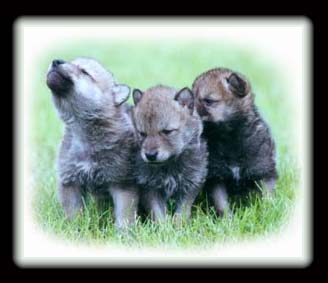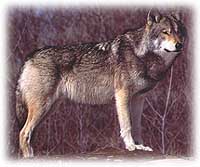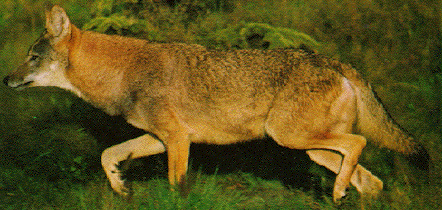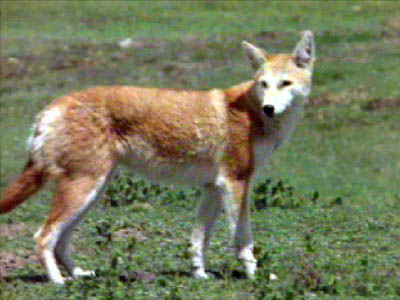There are an estimated minimum of 150,000 wolves in more than 37 countries. Most countries give legal protection to wolves and most wolf populations are stable or increasing.
Wolves survive in very different climates because they have two types of fur: a thick, downy undercoat for insulation and an overcoat of long, guard hairs to repel water and snow. The undercoat will be thicker in cold weather and lighter in warm weather. In very cold weather a wolf will keep warm by curling himself into a ball and tucking his muzzle in his tail.
Wolves communicate in a number of ways. They howl, growl, whimper, whine, bark, and squeal. Whimpering or whining is often a display of friendliness. Growls threaten or enforce pack hierarchy. Barks are used to signal alarm. Howling, one of the most beautiful and haunting forms of communication in nature, brings the pack together for a hunt, solidifies pack unity, signifies a celebration, or notifies other wolves of the extent of the pack’s territory. To hear wolf howls go to The Searching Wolf.
Like men before the advent of powerful bows and guns, wolves hunt in packs. Wolf packs are between two and twenty animals. Their main prey are large herbivores such as deer, moose, and caribou, but they will eat whatever is available. Wolves usually hunt at night, looking for the weakest animals in the herd. By controlling population growth, taking out the old, the sick and the genetically inferior, wolves help protect the herds that they hunt. They also prey on the young. Once the quarry is located, wolves surround the animal, biting it wherever they can, particularly the backside, sides, neck and head. If the animal makes a spirited fight or if it is fast and can outdistance the pack, the wolves will let it go and look for easier prey. Most hunts by wolf packs are not successful. But when they are successful, the wolves gorge, eating up to 20 pounds of meat and gristle per animal. They eat almost all of the carcass leaving only hair, horns and a few bones. After a successful hunt a wolf can go up to two weeks without eating.
The pack is a tightly knit, highly organized group which travels, hunts, protects territory, and raises pups together. It has been said that the wolf pack is one of the strongest social organizations found in nature. Packs consist of a dominant male and female, called the alpha male and the alpha female, together with their offspring or other wolves related to them. On occasion, an unrelated wolf will be permitted to become a pack member. Strict hierarchy maintains order within the pack. The alpha male leads. He and the alpha female are the only members of the pack who can mate. An aide to the alpha, called the beta wolf, often acts as the caretaker of the pups and the enforcer of the alpha’s decisions. The omega wolf is the lowest ranking member of the pack, subordinate to all others, and often forced to wait for food until the rest of the pack is finished eating. The rankings often go in pairs. The alpha wolf displays a very confident stride with tail raised and ears forward. Even a glare from the alpha wolf can be sufficient to cause another wolf in the pack to show obeisance such as tucking in its tail, lowering its body and crawling to the alpha wolf, etc.







